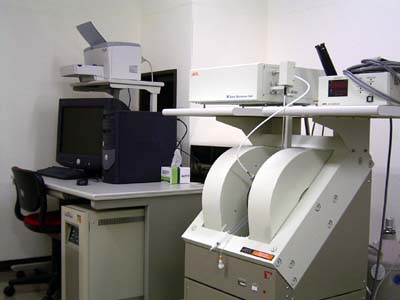|
|
 |
 |
|
 |
|
Supporting Research on the Synthesis of New Organic Molecules and Nano-Materials with Cutting-Edge Analysis Instruments |
 |
|
| |
Electron Spin Resonance Spectrometer (ESR)
|
|

Room 2 |
| The Electron Spin Resonance (ESR) Spectrometer is an analysis instrument, utilizing the phenomenon of magnetic resonance of electrons, that measures compounds having unpaired electrons (free radicals). The instrument is used to obtain information about the amount, structure, electron state and relaxation times of the free radicals through the magnetic properties of unpaired electrons.
ESR spectrometers have been widely used in studies of biological organisms and semiconductors, and used to measure magnetic properties (such as paramagnetism, diamagnetism and ferromagnetism) in substances having free radicals. For example, in fields related to biological organisms, objectives of study include active oxygen species, nitrogen monoxide, nitrogen dioxide and trace metals contianed in enzymes and proteins. In material-related fields, objectives of study include lattice defects in optical fibers or amorphous silicon, solutions in conductive high polymers and peroxidized radicals in high-polymer molecules. The ESR spectrometer has characteristics of instruments for both analysis and assessment and is used a wide range of fields such as medical science, pharmacology, sciences and oceanic and enviromental chemistry.
This spectrometer system is designed so that it can be used for a wide range of application mesurements corresponding to various study purposes, not only with the main system alone but also combined attachments. |
Specifications
Standard frequency: 8.75-9.65 GHz
Sensitivity: 7 x 109 spins/0.1 mT
(at a maximum output of 200 mW with 100 kHz magnetic-field modulation)
Resolution:2.35 microT or better
(in a 4 mm diameter x 43.5 mm region, with 100 kHz magnetic-field modulation)
Stability of magnetic field
Short term: 1 x 10-6 or 0.3 microT or better
Long term: 5 x 10-6 or 1.5 microT
|
| 2004.2.9 |
 |
|
 |
|



